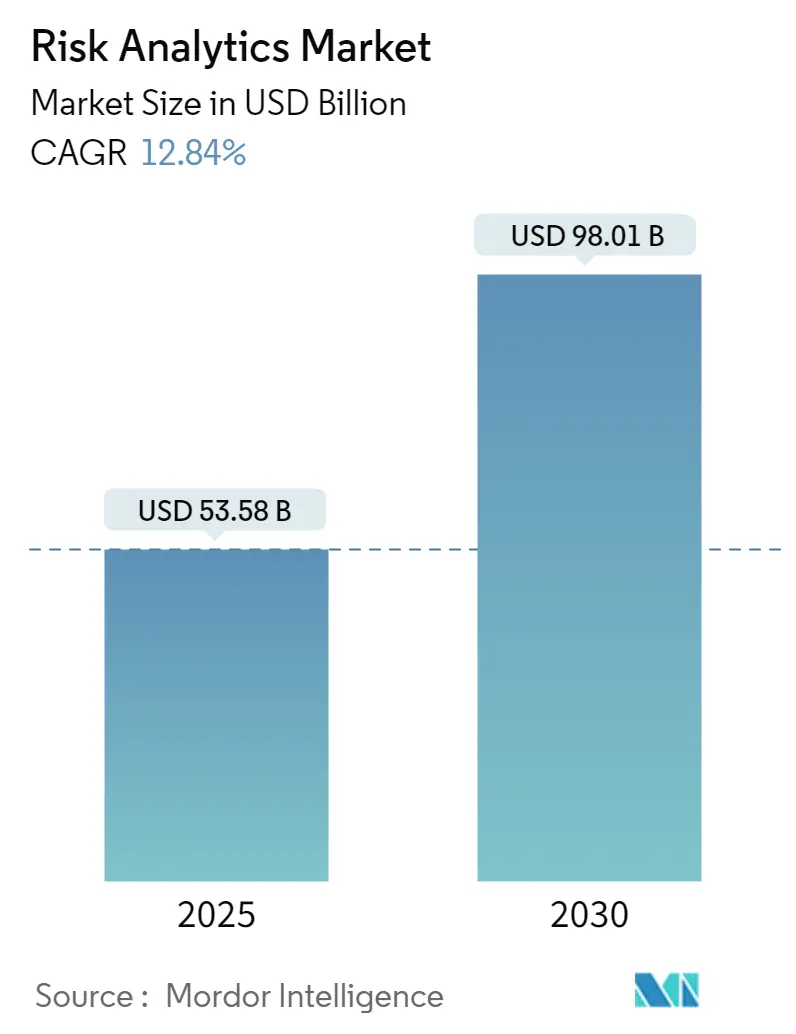
| Study Period | 2019 - 2030 |
| Market Size (2025) | USD 53.58 Billion |
| Market Size (2030) | USD 98.01 Billion |
| CAGR (2025 - 2030) | 12.84 % |
| Fastest Growing Market | Asia Pacific |
| Largest Market | North America |
| Market Concentration | High |
Major Players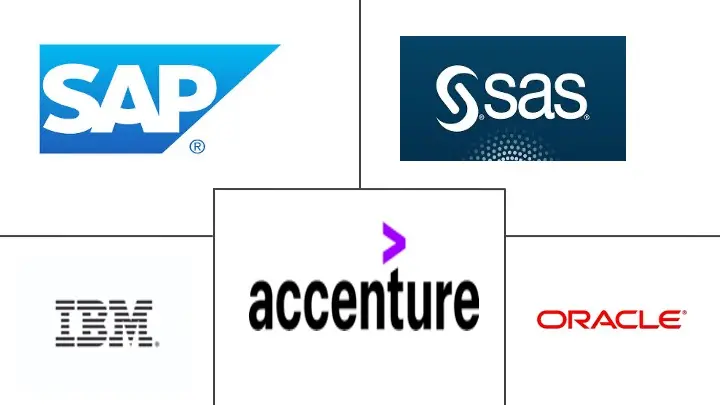
*Disclaimer: Major Players sorted in no particular order |
Risk Analytics Market Analysis
The Risk Analytics Market size is estimated at USD 53.58 billion in 2025, and is expected to reach USD 98.01 billion by 2030, at a CAGR of 12.84% during the forecast period (2025-2030).
Risk analytics solutions help organizations deal with and protect against operational risks, which can arise due to internal factors, such as human errors, failures of systems (which can be related to software, hardware, network, etc.), and fraud cybercrime.
- Currently, risk analytics techniques are enabling risk managers to measure and predict risk with more certainty than ever before. Organizations are leveraging risk analytics to gather supporting information through various security data sources to quantify their cyber risks, automate their security operations, and make intelligence-driven decisions. Additionally, organizations are witnessing increased regulatory pressure from the cyber perspective with mandates and guidance, such as the PCI-DSS and NIST Cybersecurity Framework.
- The increased usage of large amounts of structured and unstructured data in the various end-user industries boosts the demand for risk analytics to manage and save data from threats. For instance, According to Seagate Technology PLC, the global volume of data is expected to increase to 47 zettabytes and 163 zettabytes in 2020 and 2025.
- Moreover, cloud computing is driving a software revolution astonishingly as any other computing revolution of the past 40 years. As analytics for location-based risk advance, it is only sensible that they can be built and delivered using cloud-based technology rather than older server-based systems. There are several risk assessment and accumulation platforms available now through the cloud. Rules-based approaches to security, whether they are applied to threat detection, investigation, or response, can no longer keep pace with advanced cyber threats, including account compromise and malicious insiders.
- The demand for risk analytics in the banking, financial services, and insurance (BFSI) sector is also fueled by the increased use of mobile banking services and the rising volume of data. Risk analytics can be applied to combine the data into a single, comprehensive perspective, collect essential data, and produce insights that can be put to use. In addition, risk analytics are critical for logistics firms worldwide to efficiently address business disruptions and supply chain issues brought on by the spread of the coronavirus disease internationally.
Risk Analytics Market Trends
BFSI is Expected to Witness Huge Adoption of Risk Analytics Solutions
- Banks across the world are realizing that they need a more rational approach to managing a growing plethora of risks enveloping the banking and financial industries' landscape, and they have now understood the significance of risk analytics.
- Risk analytics enables banks and financial institutions to move away from the 'silo' approach to risk management and move toward the comprehensive view of enterprise-wide risks. For instance, in operational risk management (ORM), the number of transactions that need to be monitored is growing exponentially, thus implying pressure on the current banking infrastructure and enabling the market for risk analytics.
- Financial Organizations are under intense pressure to reduce fraud and meet strict regulatory compliance requirements while growing their business. Moreover, New Account Fraud and Account Takeover are the top two types of fraud challenging financial institutions today. Risk analytics solutions protect against these and other fraudulent activities across online and mobile channels, using machine learning-based risk analysis, a form of AI.
- Data analytics can be used in a variety of ways by banks to protect themselves from danger. Customer analytics, for instance, can be used to categorize customers according to their creditworthiness for credit risk management. Because one can rely on those customers to make payments on time, doing so lets individuals choose a target market for credit products and lowers exposure to default risk. According to the Global Association of Risk Professionals, it is estimated that capital markets, banking, and insurance sectors are likely to spend USD 96 billion on risk information technologies and services.
- Additionally, the Grant Thornton survey study identified that 85% of respondents believed that their bank's data and risk information management initiatives need additional efficiencies to realize their full potential. Furthermore, 82% had indicated the same for their institution's risk analytics and measurements. Hence, such trends drive the need for risk analytics solutions in the BFSI industry.
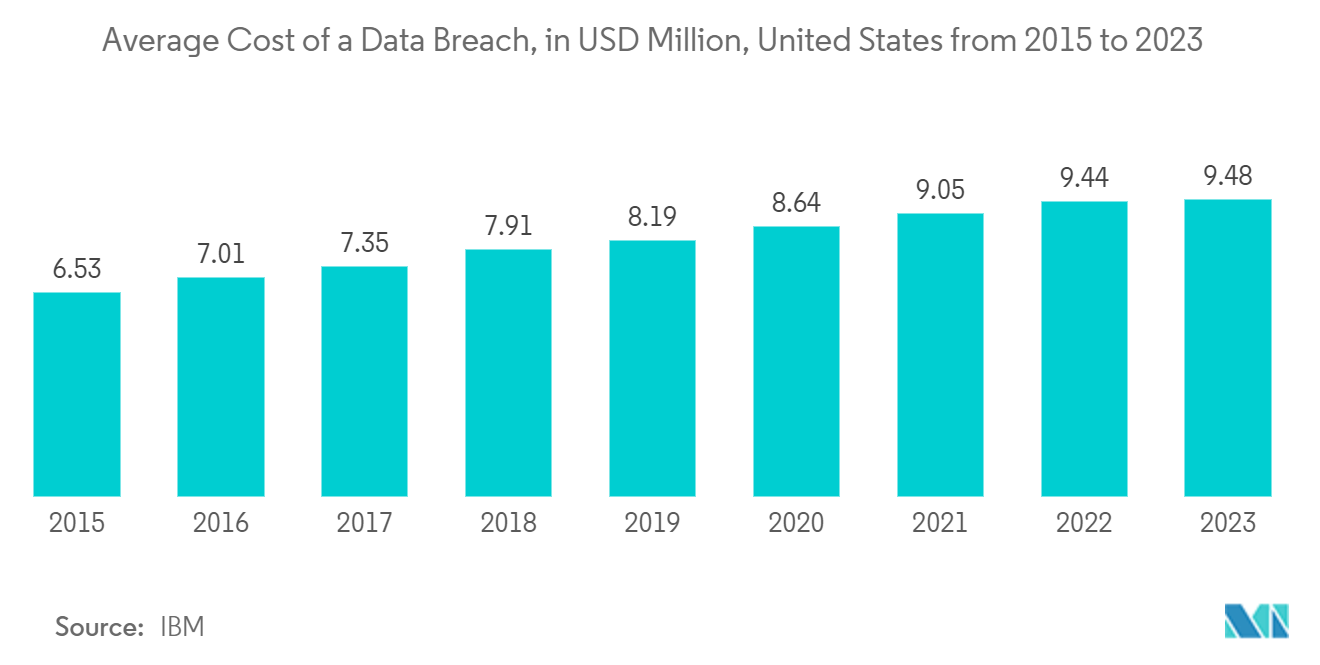
North America is Expected to Hold a Significant Share
- North America is expected to hold the highest market share, with the United States leading the market. The dominance of the region is due to its increasing adoption of risk analytics solutions among end-user industries, a significant presence of large enterprises, and drive for early technological adoption owing to competition from other businesses operating in low-cost regions.
- Moreover, adopting cloud computing across industries is driving market growth. The task of protecting Healthcare Information Systems (HIS) from immediate cyber security risks has been intertwined with cloud computing adoption. The data and resources of HISs are inherently shared with other systems for remote access, decision-making, emergency, and other healthcare-related perspectives.
- Additionally, there have been 28 data breach incidents reported during the pandemic year in the United States, including email hacking incidents, malware attacks, and unauthorized access to EHRs (source the US Department of Health & Human Services). In the medical healthcare sector, cloud computing is considered to be an immediate remedy because it is scalable as well as economical.
- The healthcare infrastructure in the United States is experiencing positive trends in the predictive analytics domain. Studies have shown that in the last few years, more than 40% of healthcare executives reported a 50% increase in data volume. As the data sets become bigger and more difficult to handle, health systems and payers increasingly adopt predictive analytics.
- Moreover, the region has a strong foothold of risk analytics vendors, which contributes to the growth of the market. Some of them include IBM Corporation, Oracle Corporation, SAS Institute Inc., and AxiomSL Ltd, among others.
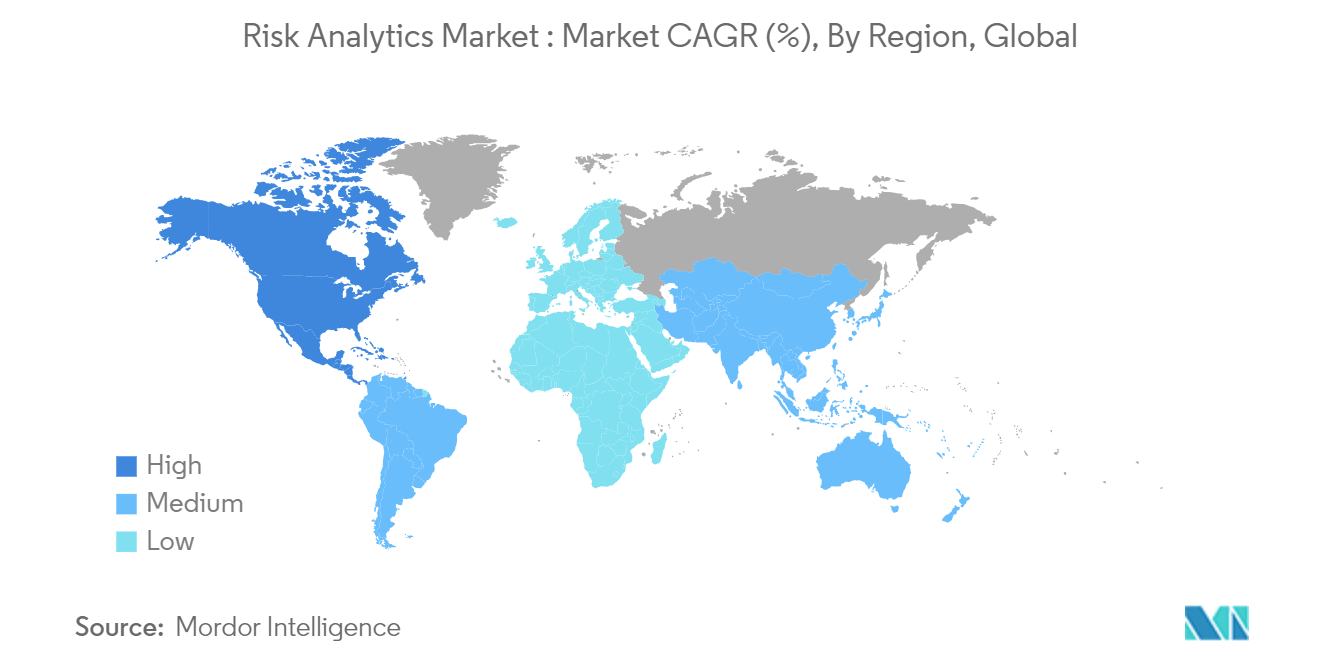
Risk Analytics Industry Overview
The risk analytics market is a relatively consolidated market as the major vendors account for a significant share of the market, especially in the enterprise-level adoption. Additionally, large companies dominate this market owing to their ability to offer innovative and high-quality services to end-users on a different scale and with customization that suits their specific needs. IBM Corporation, SAP SE, SAS Institute Inc., Oracle Corporation, Accenture PLC and Adenza Group Inc. (previosuly AxiomSL Ltd.) are a few prominent players operating in the market.
In November 2023, Renew Risk, a Software-as-a-Service (SaaS) risk analytics supplier, and GCube Insurance, a prominent insurance company for renewable energy projects, announced a strategic partnership. GCube's offshore wind clients will significantly benefit from this partnership, strengthening the company's capacity for offshore wind risk analytics and modeling. GCube will benefit from this agreement by utilizing Renew Risk's advanced catastrophe risk models, which are tailored for offshore wind portfolios.
In September 2023, Axioma, a global supplier of corporate risk solutions, portfolio construction tools, and factor risk models, announced a new partnership with Jacobi Inc. The San Francisco-based company Jacobi's technology enables dynamic client engagement, optimizes investing operations, and simplifies multi-asset portfolio building and maintenance. With this single workflow-integrated solution, investment managers can readily access time series and point-in-time risk data for factor-based decomposition across equity and multi-asset class portfolios.
In October 2022, Goldman Sachs Group, Inc., a top global investment banking, securities, and investment management organization, and Qontigo, a leading innovative risk, analytics, and index solutions provider, announced an expanded partnership. Through Goldman Sachs Financial Cloud for Data, a collection of modular data management and analytics solutions, as well as Goldman Sachs Marquee, the company's digital platform that offers market-leading data, analytics, market insights, and trading solutions to institutional investors, Qontigo would now make the Axioma Portfolio Optimize and Axioma Equity Factor Risk Models available.
In September 2022, A collaborative alliance was launched between CAMELOT Management Consultants and Everstream Analytics, a prominent provider of supply chain insights and risk analytics. This partnership combines Everstream's superior risk ratings and AI-powered analytics with CAMELOT's unrivaled strategic process design and organizational knowledge to create high-performing, compliant, resilient value chains.
Risk Analytics Market Leaders
-
IBM Corporation
-
SAP SE
-
SAS Institute Inc.
-
Oracle Corporation
-
Accenture PLC
- *Disclaimer: Major Players sorted in no particular order
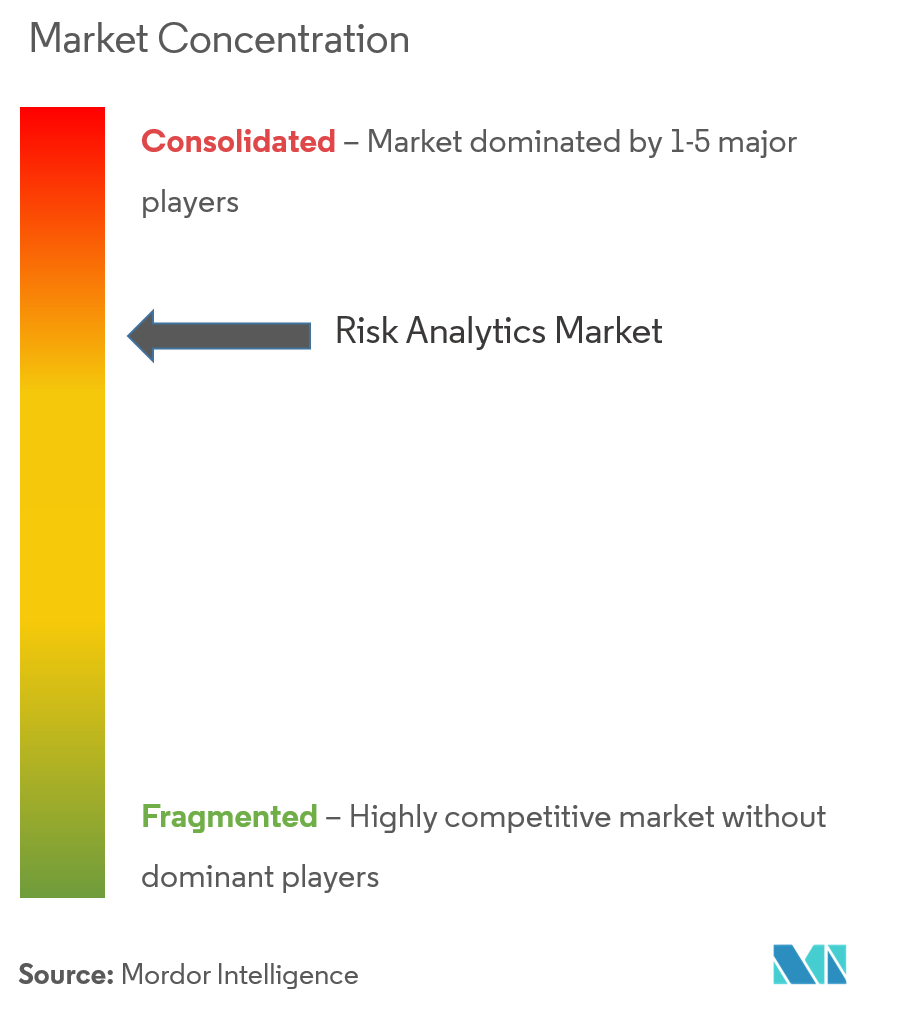
Risk Analytics Market News
- November 2023 - SimCorp, a Denmark-based software company, announced it will merge with Axioma, a global supplier of multi-asset class enterprise risk solutions, factor risk models, and tools for building portfolios. This dynamic, front-to-back platform remains crucial due to the combined strength of Axioma and SimCorp. As its primary growth market, SimCorp's merger with Axioma strengthens its position in significant regions like North America.
- August 2023 - Kearney, a management consulting company, and Everstream Analytics, a California-based risk analytics software firm focusing on supply chain, expanded their partnership. This agreement will combine Everstream's AI-powered, automated risk analytics with Kearney's operational supply chain framework and incorporate compliance and ESG standard expertise. Kearney claims that proactive risk management and regulatory compliance are critical company needs requiring a comprehensive approach.
- November 2022: As the business expands, New York-based MGA Elpha Secure teamed with CyberCube to use two of its cyber risk analytics tools to make a strong case for capacity from suppliers active in the ILS market.
- November 2022: Synspective, a provider of synthetic aperture radar (SAR) satellite data and solutions, and Geo Climate Risk Solutions Pvt. Ltd. (GCRS), a solution provider, consultancy, and advisory services firm that focuses on natural hazards risk analytics and environmental and sustainability challenges are happy to announce a new partnership for SAR-based analysis solutions for critical infrastructure and mining industries in India and throughout South Asia. GCRS and Synspective will collaborate to offer risk analysis solutions for the mining and critical infrastructure sectors to speed up regional net-zero projects.
Risk Analytics Industry Segmentation
A part of a risk management environment, risk analytics is a type of business intelligence. It is optional to use a digital solution; companies have been employing manual or somewhat automated approaches for years to analyze and assess risk. Vendors are offering this software through on-premise and cloud deployment for end-user industries, such as BFSI, healthcare, IT, and telecom, which are considered in this study.
The risk analytics market is segmented by component (solution, service), deployment (on-premise, cloud), end-user vertical (BFSI, healthcare, IT, and telecom), and geography (North America (United States, Canada), Europe (Germany, UK, France, Spain, and Rest of Europe), Asia-Pacific (China, Japan, India, Australia, and Rest of Asia-Pacific), and Latin America (Brazil, Mexico, Argentina, and Rest of Latin America), and Middle East & Africa (UAE, Saudi Arabia, South Africa, and Rest of MEA). The market sizes and forecasts are provided in terms of value in USD for all the above segments.
| By Component | Solution | ||
| Service | |||
| By Deployment | On-premise | ||
| Cloud | |||
| By End-user Vertical | BFSI | ||
| Healthcare | |||
| Retail | |||
| Manufacturing | |||
| Other End-user Verticals (IT and Telecom) | |||
| Geography*** | North America | United States | |
| Canada | |||
| Europe | Germany | ||
| United Kingdom | |||
| France | |||
| Spain | |||
| Asia | China | ||
| Japan | |||
| India | |||
| Australia and New Zealand | |||
| Latin America | Brazil | ||
| Mexico | |||
| Argentina | |||
| Middle East and Africa | United Arab Emirates | ||
| Saudi Arabia | |||
| South Africa | |||
Risk Analytics Market Research FAQs
How big is the Risk Analytics Market?
The Risk Analytics Market size is expected to reach USD 53.58 billion in 2025 and grow at a CAGR of 12.84% to reach USD 98.01 billion by 2030.
What is the current Risk Analytics Market size?
In 2025, the Risk Analytics Market size is expected to reach USD 53.58 billion.
Who are the key players in Risk Analytics Market?
IBM Corporation, SAP SE, SAS Institute Inc., Oracle Corporation and Accenture PLC are the major companies operating in the Risk Analytics Market.
Which is the fastest growing region in Risk Analytics Market?
Asia Pacific is estimated to grow at the highest CAGR over the forecast period (2025-2030).
Which region has the biggest share in Risk Analytics Market?
In 2025, the North America accounts for the largest market share in Risk Analytics Market.
What years does this Risk Analytics Market cover, and what was the market size in 2024?
In 2024, the Risk Analytics Market size was estimated at USD 46.70 billion. The report covers the Risk Analytics Market historical market size for years: 2019, 2020, 2021, 2022, 2023 and 2024. The report also forecasts the Risk Analytics Market size for years: 2025, 2026, 2027, 2028, 2029 and 2030.
Our Best Selling Reports
Risk Analytics Industry Report
Statistics for the 2025 Risk Analytics market share, size and revenue growth rate, created by Mordor Intelligence™ Industry Reports. Risk Analytics analysis includes a market forecast outlook for 2025 to 2030 and historical overview. Get a sample of this industry analysis as a free report PDF download.




